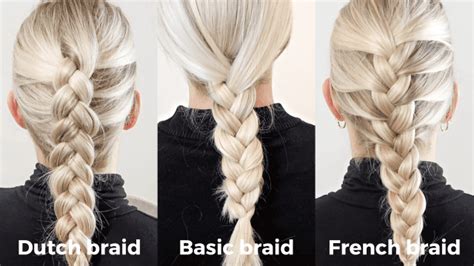Introduction
Braiding is an art form that has been passed down through generations, with countless variations and styles to choose from. Among the most popular types of braids are Dutch braids and French braids, each offering its own unique look and technique. In this article, we will delve into a comprehensive comparison between these two braiding methods, highlighting their key differences, advantages, and applications.

Key Differences
1. Direction of Weaving
- Dutch Braids: The strands of hair are added diagonally over the center strand, creating a raised, “inside-out” effect.
- French Braids: The hair strands are added diagonally under the center strand, resulting in a flat, “outside-in” appearance.
2. Starting Point
- Dutch Braids: Commence at the crown of the head, working down towards the nape.
- French Braids: Typically start closer to the hairline, gradually moving towards the back of the head.
3. Width and Coverage
- Dutch Braids: Create a wider, more voluminous look due to the overhand weaving method.
- French Braids: Result in a narrower, flatter braid that covers a smaller area of the scalp.
Advantages of Dutch Braids
1. Volume and Texture
The overhand weaving technique of Dutch braids generates significant volume and texture, making it an ideal choice for fine or flat hair.
2. Holds Well
The diagonal weaving method creates a secure and long-lasting hold, making Dutch braids suitable for active lifestyles.
3. Versatile Styling
Dutch braids can be styled in various ways, including buns, ponytails, and crowns, due to their raised design.
Advantages of French Braids
1. Elegant and Refined
French braids exude a classic, elegant look that complements formal or special occasions.
2. Simple and Effortless
The underhand weaving technique is easier to master than Dutch braids, making them a beginner-friendly option.
3. Discreet and Functional
French braids blend seamlessly into the hair, offering a discreet and functional way to manage unruly locks.
Applications
1. Protective Styling
Both Dutch and French braids provide protective styling options for natural or chemically treated hair.
2. Bridal Hair
Dutch and French braids are popular choices for bridal hairstyles, offering elegance and versatility.
3. Formal Events
These braids are suitable for formal events such as proms, evening parties, and weddings.
Step-by-Step Guide
Dutch Braid
- Divide your hair into three equal strands.
- Cross the right strand over the center strand.
- Repeat step 2, but this time with the left strand.
- Pick up a small section of hair from the right side and add it to the right strand.
- Cross the modified right strand over the center strand.
- Repeat step 5 with the left side.
- Continue this process until you reach the nape of your neck.
- Secure the end with an elastic band.
French Braid
- Divide your hair into three equal strands.
- Cross the right strand under the center strand.
- Repeat step 2, but this time with the left strand.
- Pick up a small section of hair from the right side and add it to the right strand.
- Cross the modified right strand under the center strand.
- Repeat step 5 with the left side.
- Continue this process until you reach the nape of your neck.
- Secure the end with an elastic band.
Customer Needs and Wants
1. Volume and Texture
Customers seeking volume and fullness in their hair will prefer Dutch braids.
2. Elegance and Refinement
For those who desire a timeless and sophisticated look, French braids are the ideal choice.
3. Ease of Maintenance
French braids are suitable for customers who value convenience and ease of maintenance.
4. Protective Styling
Customers looking for ways to protect their hair while styling will appreciate the benefits of Dutch and French braids.
Conclusion
Dutch braids and French braids offer distinct advantages and applications. Dutch braids excel in providing volume, texture, and durability, while French braids showcase elegance, simplicity, and versatility. The choice between the two ultimately depends on the individual’s personal style, hair type, and desired outcome. By understanding the key differences and advantages of each method, hairstylists and individuals alike can create stunning, customized braids that cater to the unique needs and preferences of their clientele.
Tables
Table 1: Key Differences Between Dutch Braids and French Braids
| Feature | Dutch Braids | French Braids |
|---|---|---|
| Direction of Weaving | Diagonally over | Diagonally under |
| Starting Point | Crown of the head | Near the hairline |
| Appearance | Raised, voluminous | Flat, narrow |
Table 2: Advantages of Dutch Braids
| Advantage | Description |
|---|---|
| Volume and Texture | Creates significant volume and texture |
| Strong Hold | Secure and long-lasting hold due to overhand weaving |
| Styling Versatility | Can be styled into various updos and down hairstyles |
Table 3: Advantages of French Braids
| Advantage | Description |
|---|---|
| Elegant and Refined | Classic, polished look suitable for formal occasions |
| Simple and Effortless | Easier to master than Dutch braids |
| Discreet and Functional | Blends seamlessly into hair, providing a discreet way to manage unruly locks |
Table 4: Applications of Dutch and French Braids
| Application | Description |
|---|---|
| Protective Styling | Both braids provide protective styling options for natural or chemically treated hair |
| Bridal Hair | Popular choices for bridal hairstyles, offering elegance and versatility |
| Formal Events | Suitable for proms, evening parties, and weddings |
